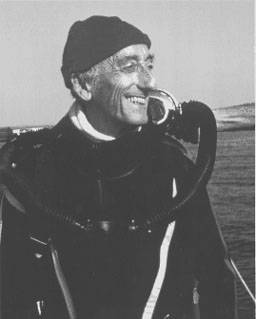| Jacques Cousteau  AKA Jacques-Yves Cousteau AKA Jacques-Yves Cousteau
Born: 11-Jun-1910
Birthplace: Saint-André-de-Cubzac, France
Died: 25-Jun-1997
Location of death: Paris, France
Cause of death: Heart Failure
Remains: Buried, Saint-André-de-Cubzac Cemetery, Gironde, France
Gender: Male
Race or Ethnicity: White
Sexual orientation: Straight
Occupation: Activist, Inventor, TV Personality Nationality: France
Executive summary: Oceanographer, environmentalist Military service: French Navy, to Lt. Cmdr. (1930-57) Jacques Cousteau (kūstō') was a filmmaker and self-taught oceanographer, and by far the most famous undersea explorer of the 20th century. He learned to swim when he was an infant. Swimming became his hobby, and, by adolescence, his passion. Later in life he was sometimes called "the manfish".
He joined the French Navy fresh from high school, and served for 27 years. During his Navy time, he made several improvements to breathing machines for longer dives, and developed new and improved methods of underwater photography. In 1943, with French engineer Emile Gagnan (1900-1979), he invented the Aqua-Lung, a mechanism that allows divers to swim underwater while breathing compressed air, and remains a component in modern scuba diving equipment.
His earliest films were about deep-sea hunting and fishing, but he made his fame on conservationism. He won three Oscars for theatrical documentaries, but was best known to ordinary people for a long-running series of television programs, beginning with a 1966 TV special, The World of Jacques-Yves Cousteau, and continuing through and beyond the long-running The Undersea World of Jacques Cousteau. He traveled the world's oceans in a converted minesweeper named Calypso, the ship that served as the recurring motif for his television adventures. The programs were narrated with a ceaseless sense of wonder by Cousteau himself, in English through a frequently-parodied Gallic accent, as he described and showed life at the depths of the "water planet" and made science popular on prime time television world-wide.
Contrary to the popular perception, though, Cousteau was rarely on Calypso except when cameras were rolling. His schedule was busy with fundraising, speechmaking, political lobbying, writing numerous books, and his day job as the Director of the Oceanographic Museum and Aquarium in Monaco for more than three decades. He was an environmental activist in a time when that phrase needed to be explained, campaigning, for example, against a 1960 French plan to dump nuclear waste into the Mediterranean Sea. He established the Cousteau Foundation in 1973, dedicated to marine exploration and research. His last filmed work was a 1989 documentary on the Exxon Valdez oil spill in Alaska, and long after his death his name and work are still despised by those who oppose virtually any steps to protect the environment.
He had two children with his first wife, Simone, and two more with his long-time mistress, Francine, whom he married in 1991 after his wife's death, and who is now chair of the Cousteau Foundation. Several of his children and grandchildren have worked in documentary filmmaking, environmental protection, and eco-tourism, leading to at least two well-publicized lawsuits over the rights to the family's famous last name and formidable estate, which includes an enormous catalog of films, television programs, photographs, and books, control of the Cousteau Society, and the fate of the fabled Calypso. His brother, Pierre-Antoine Cousteau, was a prominent fascist writer and Nazi sympathizer during World War II. Father: Daniel Cousteau (lawyer)
Mother: Elizabeth Cousteau
Brother: Pierre-Antoine Cousteau (pro-Nazi war criminal, b. 18-Mar-1906, d. 17-Dec-1958)
Wife: Simone Melchior Cousteau (b. 19-Jan-1919, m. 12-Jul-1937, d. 1-Dec-1990, cancer)
Son: Jean-Michel Cousteau (b. 8-May-1938)
Son: Phillipe Cousteau (b. 30-Dec-1940, d. 28-Jun-1979, plane crash)
Wife: Francine Triplet Cousteau (b. circa 1950, m. 28-Jun-1991 until his death, two children)
Daughter: Diane Cousteau (b. 1980)
Son: Pierre-Yves Cousteau (b. 1982)
High School: Stanislas Academy, Paris, France (1930)
University: École Navale, Brest, France
Croix de Guerre World War II
National Geographic Gold Medal 1961
Oscar for Best Documentary 1957, for Le Monde du Silence
Oscar for Short Film 1959, for The Golden Fish
Oscar for Best Documentary 1965, for Le Monde sans Soleil
French Legion of Honor Commander
Presidential Medal of Freedom 23-May-1985
The Undersea World of Jacques Cousteau (1968-75)
Oceanographic Museum and Aquarium Director (1957-88)
Cousteau Foundation Founder (1973)
National Academy of Sciences
National Geographic Society
Explorers Club
French Academy 1989
Heart Attack 25-Jun-1997 (fatal)
Asteroid Namesake 6542 Jacquescousteau
FILMOGRAPHY AS DIRECTOR
World Without Sun (1964)
The Silent World (May-1956)
FILMOGRAPHY AS ACTOR
The Silent World (May-1956) · Himself
Official Website:
http://www.cousteau.org/
Author of books:
The Silent World (1952, with Frederic Dumas)
The Living Sea (1963, with James Dugan)
World Without Sun (1965)
The Shark: Splendid Savage of the Sea (1970, with Phillipe Cousteau)
Oasis in Space (1972)
The Ocean World of Jacques Cousteau (1973, twenty volumes)
Dolphins (1975)
The Cousteau Almanac: An Inventory of Life on Our Water Planet (1981)
Jacques Cousteau's Amazon Journey (1984, with Mose Richards)
Whales (1988)
Jacques Cousteau's Journey to Papua New Guinea (1984, with Mose Richards)
The Human, the Orchid, and the Octopus (1996, posthumous; with Susan Schiefelbein)
Requires Flash 7+ and Javascript.
Do you know something we don't?
Submit a correction or make a comment about this profile
Copyright ©2019 Soylent Communications
|